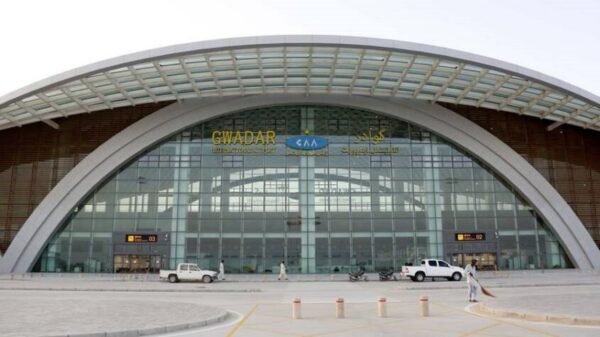Does Pakistan’s New Gwadar International Airport is Meant for War?

The Gwadar International Airport in Pakistan, built with significant Chinese investment, has raised concerns and speculation about its potential dual-use, both for civilian and military purposes. Here’s a breakdown of the factors contributing to this:
Strategic Location:
Gwadar’s location on the Arabian Sea gives it significant strategic importance. It’s a key part of the China-Pakistan Economic Corridor (CPEC), a major component of China’s Belt and Road Initiative.
This location is vital for maritime trade and also holds potential military significance.
Chinese Involvement:
The airport’s construction is largely funded by China, which has led to concerns about potential Chinese military access and influence.
The close strategic partnership between Pakistan and China adds to these concerns.
Dual-Use Potential:
Large modern airports can be readily adapted for military use, including the deployment of aircraft and logistical support.
Given the geopolitical dynamics in the region, the possibility of the Gwadar airport serving military purposes cannot be entirely dismissed.
Economic vs. Military:
It is important to remember that the stated purpose of the airport is to boost economic development in the Gwadar region. The CPEC project as a whole is presented as an economic project.
However, infrastructure projects in strategic locations frequently have dual purpose potential.
Pakistan’s $240 million Gwadar International Airport is primarily being built as part of the China-Pakistan Economic Corridor (CPEC) to boost trade, connectivity, and regional development. However, some analysts suggest that its design and strategic location could have military applications.
Key Points About Gwadar Airport:
Economic Purpose: The airport is meant to enhance commercial aviation and cargo transport, supporting Gwadar’s role as a trade hub under CPEC.
Chinese Involvement: China has fully funded the airport, raising speculation about its potential dual-use (civilian and military).
Strategic Location: Gwadar’s proximity to the Arabian Sea and key global shipping routes makes it significant for both economic and defense interests.
Runway Capabilities: Reports indicate it will have a 3,650-meter runway, capable of handling large military aircraft if needed.
Possible Military Use: Some analysts argue that the airport could support Chinese or Pakistani military operations, particularly in naval logistics and air surveillance.
While officially a commercial project, Gwadar Airport’s infrastructure and China’s growing influence in the region fuel concerns about its potential military applications, especially among rivals like India and the U.S. However, no official confirmation exists about its direct use for warfare.
Pakistan’s New Gwadar International Airport, a $240 million project funded entirely by China, has recently drawn attention due to its current state of inactivity. Completed in October 2024 and officially opened in January 2025, the airport is designed to handle 400,000 passengers annually but remains without scheduled flights or passengers, raising questions about its purpose and utility.
Background and Purpose
The airport is a significant component of the China-Pakistan Economic Corridor (CPEC), which aims to connect China’s Xinjiang province to the Arabian Sea through a series of infrastructure projects. While officials have touted the airport as a major development for Pakistan, many locals in Gwadar express skepticism, viewing it as primarily serving Chinese interests rather than those of the local population. Azeem Khalid, an expert on Pakistan-China relations, stated, “This airport is not for Pakistan or Gwadar; it is for China, so they can have secure access for their citizens to Gwadar and Balochistan”.
Local Conditions and Security Concerns
Gwadar itself faces significant challenges, including inadequate infrastructure such as unreliable electricity and clean water supplies. The local population of approximately 90,000 people does not see the airport as a priority given their immediate needs. Furthermore, the region has been plagued by security issues, with increasing separatist violence targeting both Pakistani forces and Chinese nationals involved in local projects. In response to these threats, the Pakistani government has heightened its military presence in Gwadar, creating a heavily monitored environment characterized by checkpoints and restrictions on movement.
Economic Impact and Local Sentiment
Despite claims that CPEC has generated jobs, there is little evidence that local residents have benefited from these initiatives. Many locals feel marginalized and express frustration over being excluded from opportunities that arise from these large-scale projects. Protests over basic amenities continue, highlighting a disconnect between government promises and the reality faced by residents.
The airport’s lack of operational flights underscores broader concerns about the viability of such projects in meeting local needs while simultaneously serving geopolitical interests. As one resident lamented about the increased security measures: “Nobody used to ask where we are going… Now we are asked to prove our identity”.
while the New Gwadar International Airport stands as a symbol of ambitious infrastructure development under CPEC, its current dormancy raises critical questions about its alignment with local needs and the broader implications of foreign investment in Pakistan’s strategic regions.
In essence, while the official narrative emphasizes the airport’s economic role, its strategic location and the involvement of China fuel speculation about its potential military applications.
